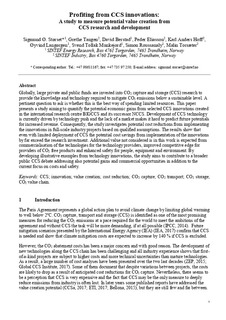| dc.contributor.author | Størset, Sigmund Østtveit | |
| dc.contributor.author | Tangen, Grethe | |
| dc.contributor.author | Berstad, David Olsson | |
| dc.contributor.author | Eliasson, Peder | |
| dc.contributor.author | Hoff, Karl Anders | |
| dc.contributor.author | Langørgen, Øyvind | |
| dc.contributor.author | Munkejord, Svend Tollak | |
| dc.contributor.author | Roussanaly, Simon | |
| dc.contributor.author | Torsæter, Malin | |
| dc.date.accessioned | 2019-08-13T10:40:48Z | |
| dc.date.available | 2019-08-13T10:40:48Z | |
| dc.date.created | 2019-03-06T09:34:49Z | |
| dc.date.issued | 2019 | |
| dc.identifier.citation | International Journal of Greenhouse Gas Control. 2019, 83 208-215. | nb_NO |
| dc.identifier.issn | 1750-5836 | |
| dc.identifier.uri | http://hdl.handle.net/11250/2608099 | |
| dc.description.abstract | Globally, large private and public funds are invested into CO2 capture and storage (CCS) research to provide the knowledge and technology required to mitigate CO2 emissions below a sustainable level. A pertinent question to ask is whether this is the best way of spending limited resources. This paper presents a study aiming to quantify the potential economic gains from selected CCS innovations created in the international research centre BIGCCS and its successor NCCS. Development of CCS technology is currently driven by technology push and the lack of a market makes it hard to predict future potentials for increased revenue. Consequently, the study investigates potential cost reductions from implementing the innovations in full-scale industry projects based on qualified assumptions. The results show that even with limited deployment of CCS the potential cost savings from implementation of the innovations by far exceed the research investment. Additional value not considered is in this work is expected from commercialisation of the technologies for the technology providers, improved competitive edge for providers of CO2 free products and enhanced safety for people, equipment and environment. By developing illustrative examples from technology innovations, the study aims to contribute to a broader public CCS debate addressing also potential gains and commercial opportunities in addition to the current focus on costs and safety. | nb_NO |
| dc.description.abstract | Profiting from CCS innovations: A study to measure potential value creation from CCS research and development | nb_NO |
| dc.language.iso | eng | nb_NO |
| dc.publisher | Elsevier | nb_NO |
| dc.rights | Attribution-NonCommercial-NoDerivatives 4.0 Internasjonal | * |
| dc.rights.uri | http://creativecommons.org/licenses/by-nc-nd/4.0/deed.no | * |
| dc.title | Profiting from CCS innovations: A study to measure potential value creation from CCS research and development | nb_NO |
| dc.type | Journal article | nb_NO |
| dc.type | Peer reviewed | nb_NO |
| dc.description.version | acceptedVersion | nb_NO |
| dc.source.pagenumber | 208-215 | nb_NO |
| dc.source.volume | 83 | nb_NO |
| dc.source.journal | International Journal of Greenhouse Gas Control | nb_NO |
| dc.identifier.doi | 10.1016/j.ijggc.2019.02.015 | |
| dc.identifier.cristin | 1682532 | |
| dc.relation.project | Norges forskningsråd: 257579 | nb_NO |
| cristin.unitcode | 7548,60,0,0 | |
| cristin.unitcode | 7401,80,40,0 | |
| cristin.unitcode | 7401,80,7,0 | |
| cristin.unitcode | 7548,70,0,0 | |
| cristin.unitname | Gassteknologi | |
| cristin.unitname | Prosessteknologi | |
| cristin.unitname | Petroleum | |
| cristin.unitname | Termisk energi | |
| cristin.ispublished | true | |
| cristin.fulltext | postprint | |
| cristin.qualitycode | 2 | |

